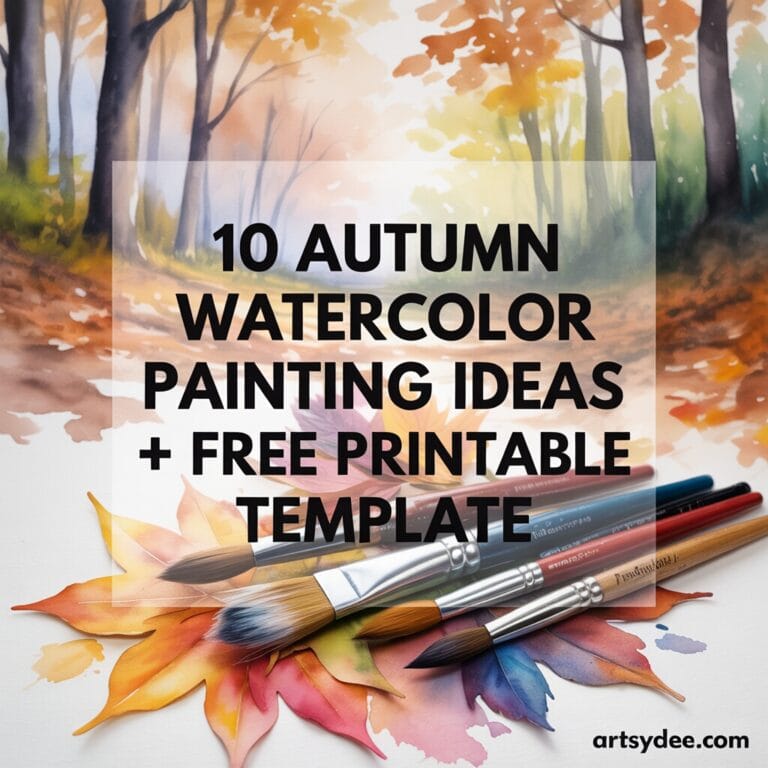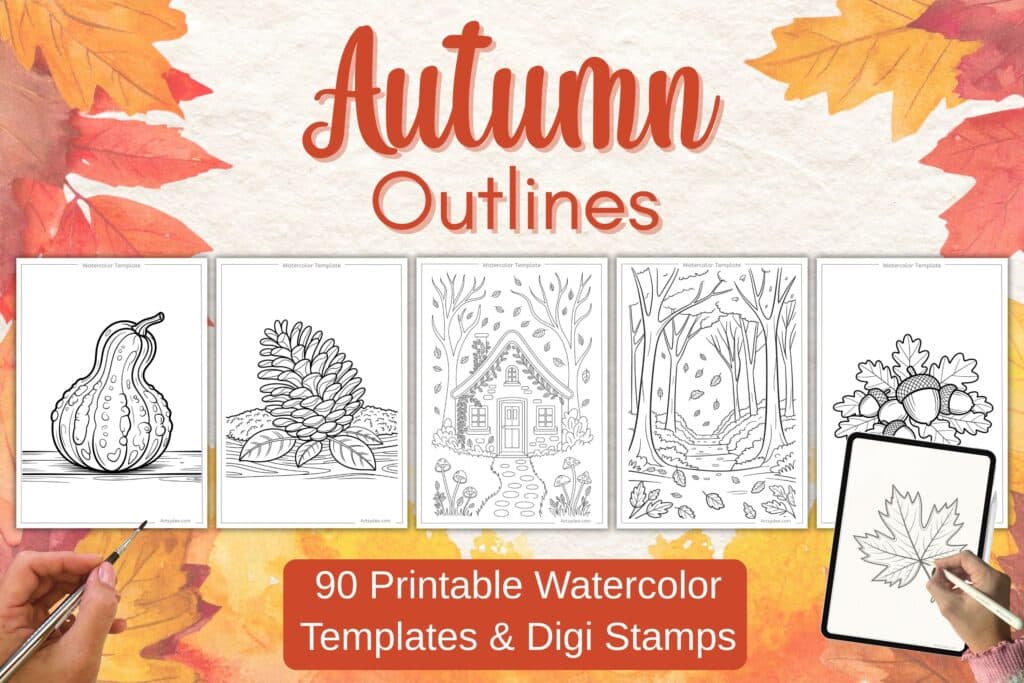Last Updated on September 15, 2025 by Dee
Autumn offers a perfect chance to slow down and capture the beauty of the season on paper. With crisp air, warm colors, and simple watercolor techniques, anyone can create art that reflects the charm of fall.
From pumpkins and golden leaves to cozy cabins and forest paths, each idea highlights a different side of the season. The templates give a helpful starting point. If you need some help getting started on your own Autumn Watercolor Paintings, Check out my full set of Autumn Watercolor Templates & Digital Stamps here – Autumn Templates.
Grab the free watercolor template for Autumn at the end of this post!
Table of Contents
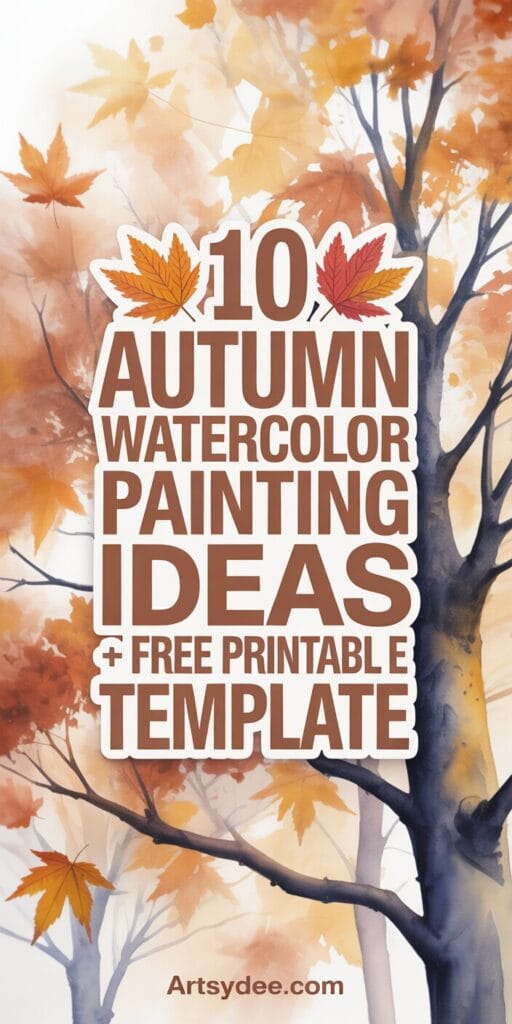
1) Pumpkin Patch Watercolor Template
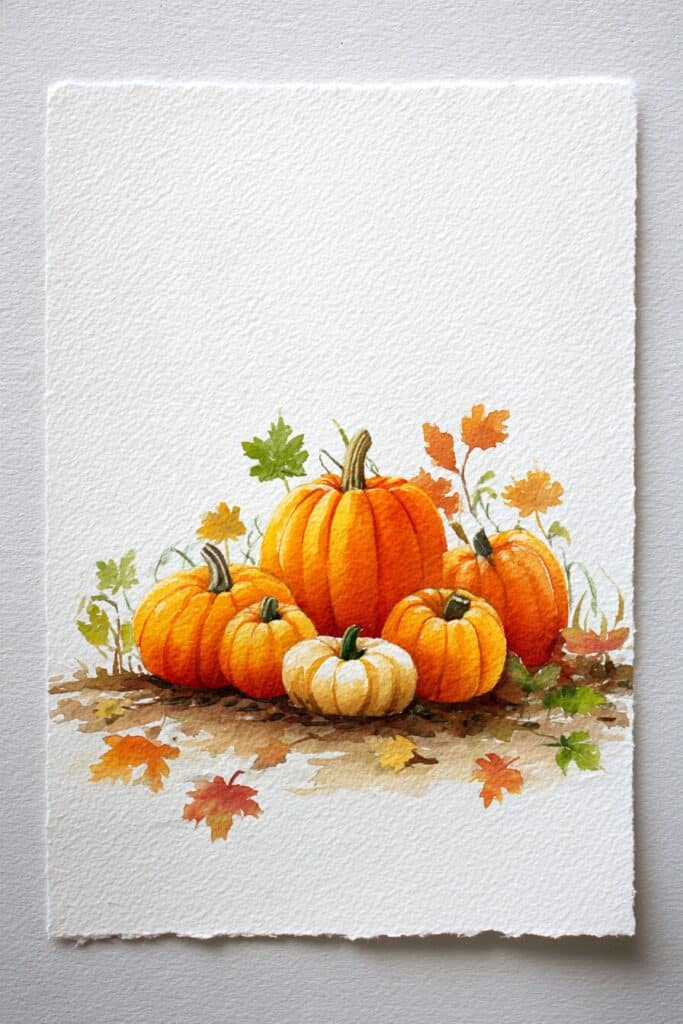
A pumpkin patch watercolor template gives artists a simple way to capture one of autumn’s most familiar sights. Pumpkins are a classic fall subject, and their round shapes make them approachable for beginners.
This type of template usually includes outlines of pumpkins in different sizes. Artists can focus on layering oranges, yellows, and browns to create depth without worrying about sketching first.
Using a template also helps keep proportions balanced. It allows painters to practice blending colors while still having a clear guide to follow.
Many free printable versions are available online, making it easy to print at home and start painting right away. Families, classrooms, or individual artists can all use them for seasonal projects.
Adding small details like vines, leaves, or shadows can make the finished piece more lively. Each person can adjust the colors to match their own style.
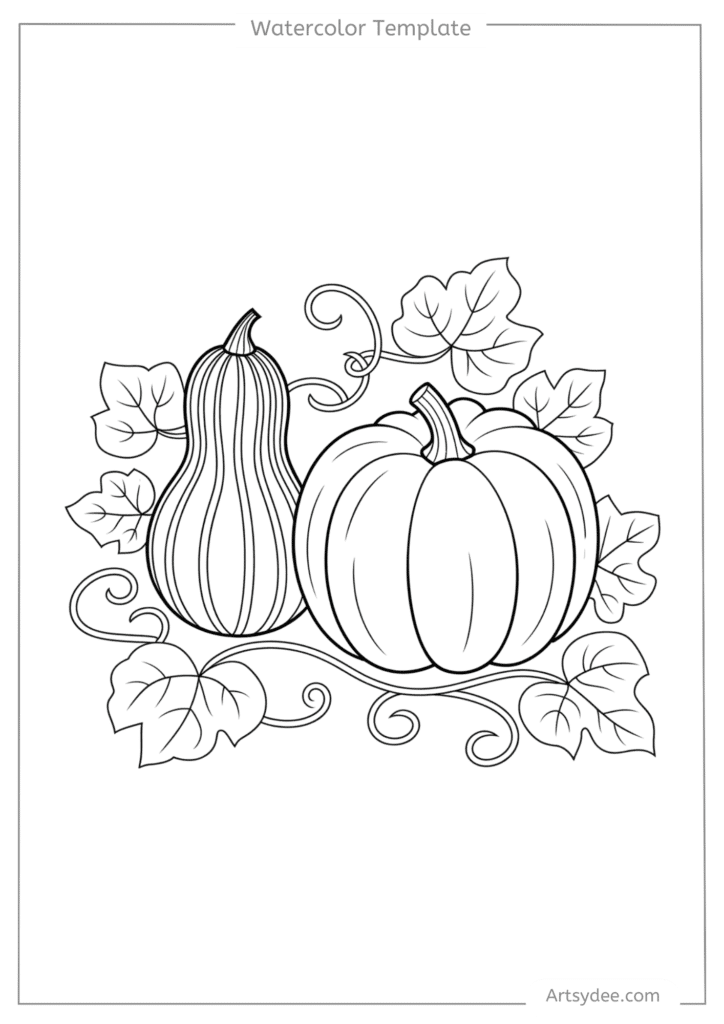
2) Golden Leaves Autumn Scene
Golden leaves make a simple but striking subject for autumn watercolor painting. The warm tones of yellow, orange, and brown capture the season’s natural beauty in a clear and direct way.

Many artists enjoy painting them because the shapes are easy to sketch and the colors blend well with watercolor. She can start with a light pencil outline of a few leaves, keeping the shapes loose and natural.
Using a wet-on-wet technique helps the colors flow into each other, creating soft edges that look like real leaves. Adding a touch of gold or warm metallic paint can give the piece an extra glow.
He might choose to place the leaves against a darker background to make the colors stand out more. A deep blue or muted purple wash can contrast nicely with the warm leaf tones.
This simple step adds depth without making the painting too complex. They can also layer several leaves together to create a fuller scene.
Overlapping shapes and varied colors give the painting a more natural look, similar to leaves scattered on the ground. This approach works well for beginners and experienced painters alike.
3) Cozy Cabin in Fall Forest

A small cabin surrounded by autumn trees makes a calm and inviting painting idea. The warm tones of orange, red, and yellow leaves create a nice contrast with the soft browns and grays of the cabin.
This simple scene feels peaceful and easy to enjoy. Artists can start by sketching a basic cabin shape with a few trees around it.
Adding layers of watercolor washes helps capture the depth of the forest and the glow of fall colors. Even beginners can keep the details light and focus on the overall mood.
Some may choose to paint smoke rising from the chimney or fallen leaves on the ground. These small details give the painting more charm without making it too complex.
The scene works well for practicing both landscape and architectural elements. Using a printable template can help with the cabin outline.
It allows the artist to focus more on color blending and brushwork instead of worrying about proportions. This makes the project approachable while still leaving room for creativity.
4) Sunflower Mason Jar Printable
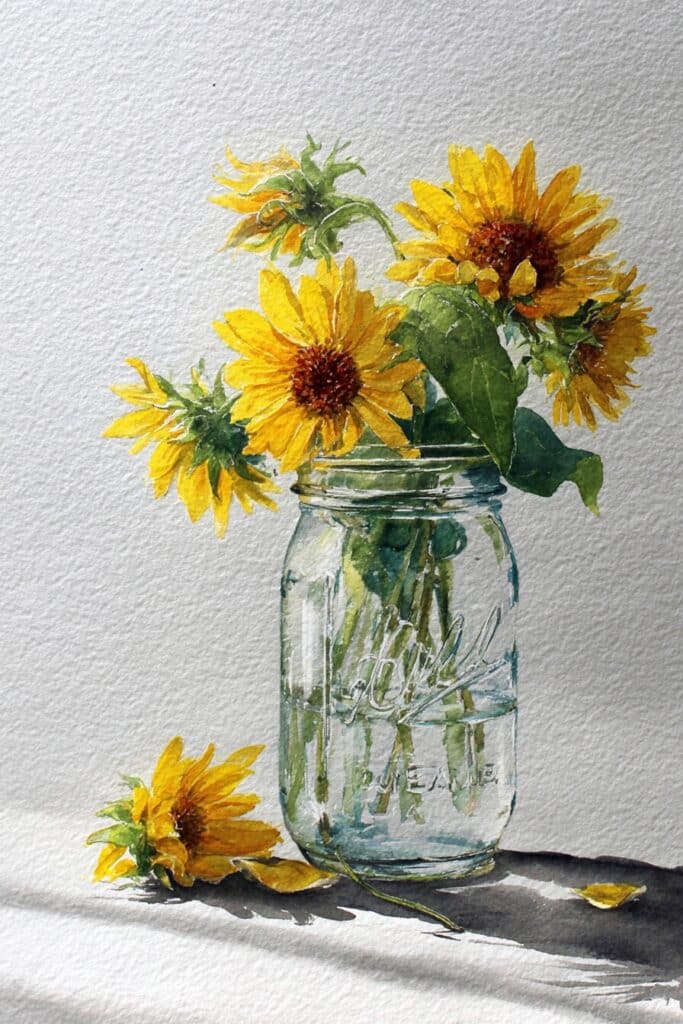
This printable features bright sunflowers arranged in a simple mason jar. The design uses soft watercolor tones that bring a warm and inviting look to any room.
Many people enjoy using this artwork for seasonal decorating. It works well in a frame, on a shelf, or even as part of a gallery wall.
The sunflower and mason jar theme also makes it a nice choice for kitchen or dining spaces. Its rustic style fits easily with fall decor without feeling overwhelming.
Because it is a printable, users can download and print it at home. This makes it an easy and affordable way to refresh a space for autumn.
Some also use the design for crafts like journals, cards, or DIY gifts. The watercolor effect adds a handmade look while still being neat and polished.
5) Outlined Maple Leaf Practice Sheet
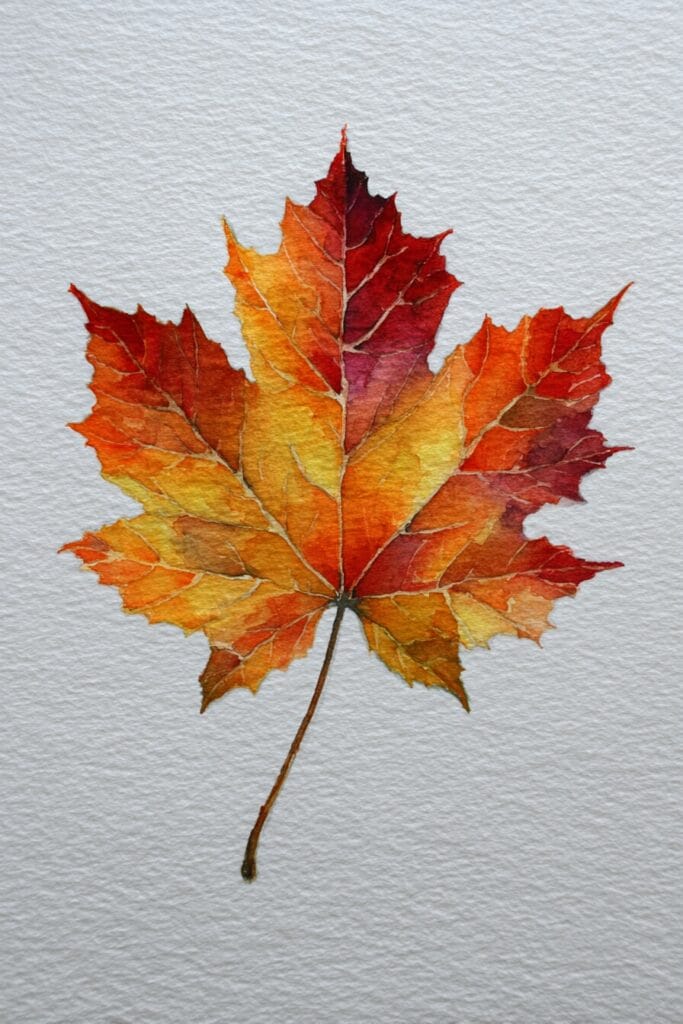
An outlined maple leaf practice sheet gives painters a simple starting point. The clean lines help them focus on color blending instead of worrying about drawing the shape.
This sheet works well for beginners who want to practice brush control. They can fill in the leaf with light washes or layer deeper shades to explore how watercolors mix.
Kids and adults can both enjoy this activity. Children may use bold colors for fun, while older learners can experiment with more realistic tones like red, orange, and gold.
The printable outline also makes it easy to repeat the exercise. Painters can print several copies to try different color combinations or techniques without redrawing the design.
Teachers and parents often use maple leaf outlines in classrooms or at home. They provide a quick way to set up an art project that connects with the autumn season.

6) Rustic Pumpkin Still Life
A rustic pumpkin still life makes a simple yet charming autumn watercolor project. The focus usually rests on pumpkins arranged with seasonal items like wildflowers, leaves, or pottery.
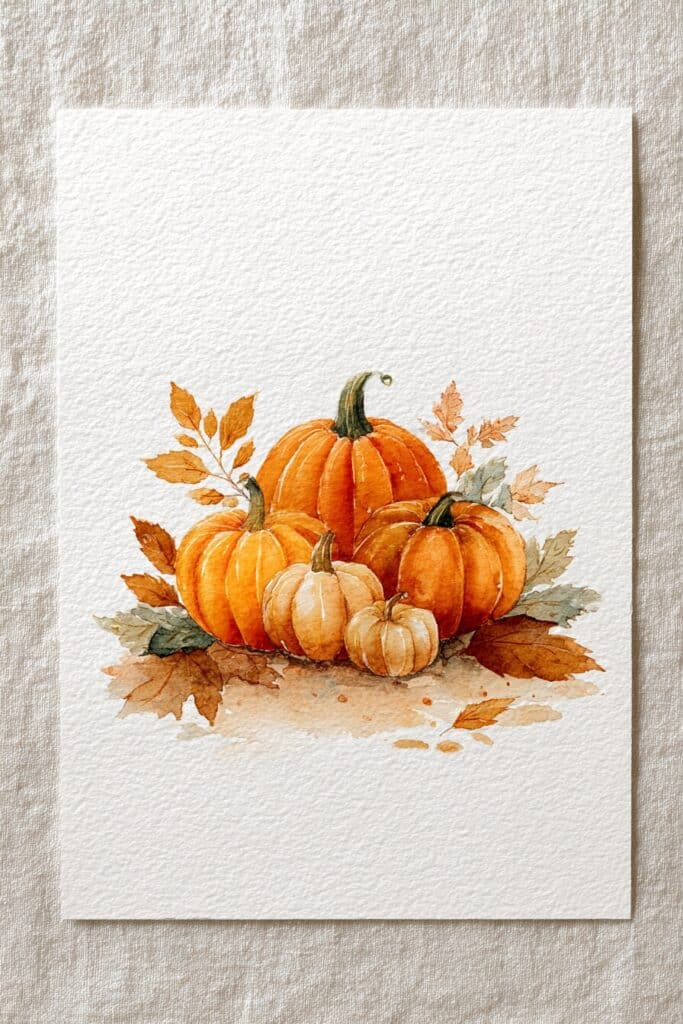
This setup works well for anyone who enjoys painting natural textures and warm colors. Artists can experiment with muted oranges, soft browns, and touches of green to capture the earthy look of fall.
Adding small details, such as weathered stems or faded petals, helps bring out the cozy, lived-in feeling of the scene. This type of painting also fits nicely into farmhouse or country-style decor.
Once finished, it can be framed and displayed as seasonal wall art. The subject is flexible, so painters can keep the arrangement simple or add more elements for variety.
For those who prefer guidance, free printable templates of pumpkin still life designs are available online. These templates help beginners sketch the basic shapes before adding watercolor layers.
It gives them a starting point while still leaving room for personal touches.
7) Autumn Forest Path Painting

An autumn forest path painting shows the beauty of trees, leaves, and light during the fall season. Artists often enjoy this subject because it combines nature and movement in a simple scene.
The path helps guide the eye through the painting. They can start with a light sketch of the path and tree outlines.
Using warm shades like orange, yellow, and red creates the look of fallen leaves. Adding soft browns and greens gives balance and depth.
Watercolor works well for this subject because it blends colors smoothly. Artists can layer washes to suggest light filtering through the trees.
A mix of wet and dry brushstrokes adds texture to the ground and foliage. This type of painting is flexible for any skill level.
Beginners can keep the path and trees simple, while more experienced painters can add details like shadows, distant branches, or scattered leaves. A free printable template can help with the basic layout.
It gives a starting point for the path and tree placement, making it easier to focus on color and technique. From there, each artist can adjust the scene to match their own style.
8) Watercolor Acorn and Oak Leaves

Acorns and oak leaves make a simple yet classic autumn subject. Their shapes are easy to sketch, and their warm colors capture the season well.
Many beginners enjoy painting them because they can practice layering and blending without needing complex details. She can start by drawing a few oak leaves with light pencil lines.
Adding one or two acorns near the base creates balance in the design. Keeping the shapes loose helps the painting feel natural.
They can use yellows, oranges, and browns for the leaves. A touch of green adds variety, especially on younger leaves.
For the acorns, soft browns with a darker cap give them a realistic look. He might try the wet-on-wet method to let colors mix softly on the paper.
This works well for leaves since their tones often blend in nature. For the acorn cap, a drier brush gives a textured effect.
This subject also works nicely for greeting cards or small framed art. The combination of acorns and oak leaves feels seasonal but not too busy, making it a versatile project for fall painting practice.
9) Fall Harvest Basket Template
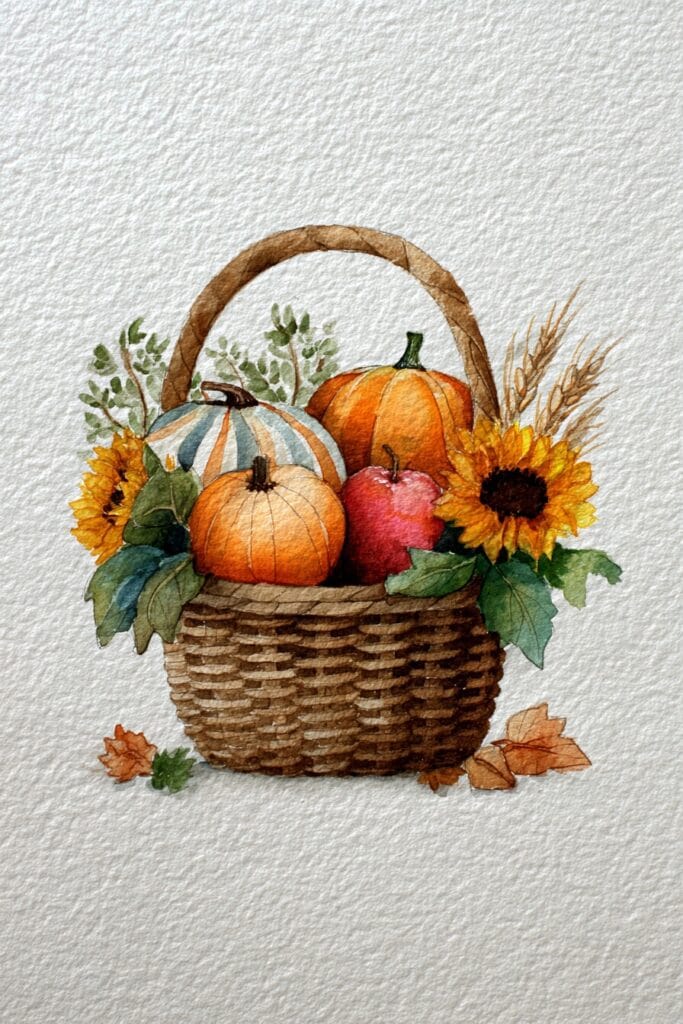
A fall harvest basket makes a warm and inviting subject for watercolor painting. The template usually features a simple basket filled with seasonal items like pumpkins, apples, or leaves.
This gives artists a clear outline to start with while leaving room for personal touches. Using the template, painters can practice layering colors to create depth in the basket and its contents.
Browns, oranges, and reds work well for a traditional autumn look, but they can also add greens or yellows for variety. This type of design works nicely for seasonal decor.
Once painted, the finished piece can be framed or used in greeting cards. The template helps beginners stay focused while still allowing creativity in how the basket is filled and shaded.
Many people enjoy this subject because it feels familiar and easy to connect with. It captures the idea of gathering and abundance that comes with autumn.
The basket design also makes a nice project for kids and adults alike.
10) Warm Sunset Over Hills

A warm sunset over rolling hills makes a simple yet calming watercolor subject. The soft blend of oranges, pinks, and yellows in the sky contrasts nicely with the darker shapes of the landscape.
This balance creates a peaceful scene that feels inviting. Painters can start with a light wash for the sky, letting the colors gently fade into one another.
Adding layers of color helps show the glow of the setting sun without making the painting look heavy. The hills can stay simple, using muted greens or browns to keep focus on the sky.
This subject works well for beginners because it relies on smooth washes and basic shapes. More experienced painters can add details like tree lines or distant shadows to give depth.
Get my full set of Autumn Watercolor Templates & Digital Stamps here – Autumn Templates.
Tips for Painting Autumn Watercolors
Artists often find fall scenes rewarding because of the rich colors, soft light, and textured details. Paying attention to color choices, brush techniques, and the way light interacts with natural forms helps create a more lifelike and balanced painting.
Choosing the Right Color Palette
Autumn colors usually include warm reds, oranges, yellows, and browns. A painter can also add muted greens, soft purples, and deep blues to balance the warmth.
Limiting the palette to a few main shades helps keep the painting cohesive. It helps to test swatches before starting.
By blending burnt sienna, cadmium orange, and yellow ochre, an artist can capture the look of fallen leaves. Adding touches of ultramarine blue or payne’s gray creates cooler tones for shadows and distance.
A simple chart can guide color mixing:
| Base Color | Mix With | Result |
|---|---|---|
| Yellow Ochre | Burnt Sienna | Golden Brown |
| Cadmium Red | Ultramarine Blue | Deep Violet |
| Orange | Payne’s Gray | Muted Rust |
Keeping colors slightly desaturated can make the scene feel more natural rather than overly bright.
Layering Techniques for Depth
Watercolor works best when built up in thin layers. Starting with light washes allows the paper to show through, giving the painting a glowing effect.
Each new layer should be slightly darker and placed only where more depth is needed. For trees, an artist might begin with a pale wash of yellow, then layer orange and red for leaves.
Adding darker tones at the base of branches creates the sense of volume. Dry brush strokes can also suggest texture, such as rough bark or scattered leaves.
By alternating between wet-on-wet for soft edges and wet-on-dry for sharp details, the painting gains both atmosphere and structure.
Capturing Light and Shadows
Light often defines autumn scenes. Soft sunlight filtering through trees or low evening light creates contrast between warm highlights and cool shadows.
Observing where the light source falls helps guide which areas to brighten and which to darken. Using diluted yellows for highlights can mimic sunlight on leaves.
Shadows can be built with layered blues or purples rather than plain black, which keeps the painting lively. Artists may also leave small areas of white paper untouched.
These unpainted spaces act as natural highlights and give the watercolor a sense of freshness. Careful placement of both light and dark areas makes the scene appear more three-dimensional.
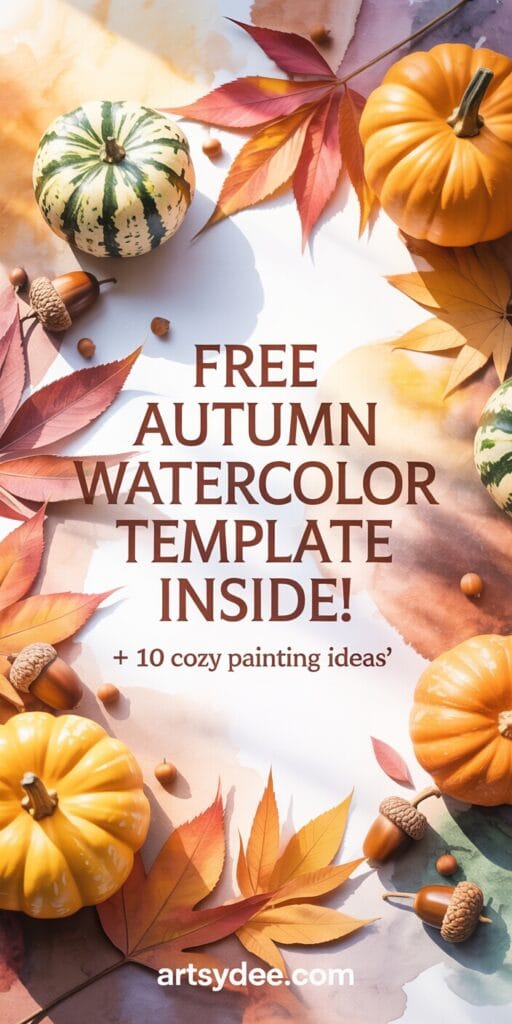
Using Free Printable Autumn Watercolor Templates
Printable templates make it easier for beginners and experienced painters to start quickly. They provide clean outlines of seasonal shapes like leaves, pumpkins, and simple landscapes that can be traced or painted directly.
How to Print and Transfer Templates
She should begin by downloading the file and checking the size options. Most templates come in standard letter or A4 formats, which fit easily on home printers.
Printing on thicker paper, such as watercolor or mixed media paper, helps prevent warping when water is applied. If her printer cannot handle heavy paper, she can print on regular copy paper first.
Then, she can transfer the design onto watercolor paper using graphite transfer paper or by holding both sheets against a bright window and tracing the outline. Another option is to use a lightbox, which makes the tracing process faster and more accurate.
For small projects like cards or tags, resizing the template before printing ensures the design fits the final piece. Keeping lines light is important, since dark outlines may show through after painting.
A soft pencil or a fine-tip erasable pen works best for tracing.
Creative Ways to Personalize Your Template
They can add variety by adjusting colors, patterns, or details within the template outline. For example, a pumpkin can be painted in traditional orange, muted pastels, or even bold blues for a modern look.
Leaves can show realistic fall tones or a rainbow blend for a playful style. Adding background washes, such as a soft gradient or splattered paint, gives the artwork more depth.
Painters may also layer extra details like shadows, veins in leaves, or textured brushstrokes to make the piece stand out. Templates are not limited to paper.
She can transfer the outlines onto fabric, wood panels, or greeting cards. This makes them useful for seasonal crafts, wall art, or handmade gifts.
Mixing templates together creates unique scenes. For instance, combining pumpkins with leaves or a simple landscape outline can form a complete autumn composition.

Frequently Asked Questions
What are some popular themes for autumn watercolor paintings?
Artists often choose pumpkins, colorful leaves, and rustic cabins as favorite subjects. Sunflowers, acorns, and woodland animals also fit well with the season.
These themes capture the warm and natural feel of autumn.
Can you recommend beginner-friendly autumn watercolor projects?
Beginners can start with a Pumpkin Patch Watercolor Template or an Outlined Maple Leaf Practice Sheet. These projects use simple shapes and allow painters to focus on blending colors without worrying about complex details.
What supplies do I need to start with autumn watercolor painting?
Basic supplies include watercolor paper, brushes, and paints in a fall color palette. A water jar, mixing palette, and paper towels also help.
Templates or practice sheets make it easier to get started without sketching.
How can I incorporate the colors of fall into my watercolor art?
Painters often use warm tones like burnt orange, golden yellow, and deep red. Adding touches of brown or muted green can balance the colors.
Layering washes of these shades helps create depth and a seasonal look.
Where can I find a free printable autumn watercolor template?
Free printables are available on art blogs, creative websites, and craft resources. Many sites offer ready-to-paint outlines, such as a Sunflower Mason Jar Printable or a Golden Leaves Autumn Scene, which can be downloaded and printed at home.
What are some techniques for painting autumn leaves in watercolor?
Wet-on-wet painting works well for blending reds, oranges, and yellows in leaf shapes.
Dry brush strokes can add texture to veins and edges.
Layering light washes first and then building darker tones helps the leaves look more natural.
Grab the Free Printable Autumn Watercolor Template here 👇🏻!
To access the free in-post printables for this post, you’ll just need to create a free account or login with the Grow.me tool. Then, confirm by email and refresh the page and ALL my free printables will automatically unlock in every post!
Love This Template? Get Even More Exclusive Creative Goodies on My Patreon! 🎨
If you’re enjoying these free printables, why not join my Artsydee Patreon community? As a member, you’ll gain access to exclusive Procreate tutorials, watercolor lessons, and tons of printables like this one—delivered to you monthly (and sometimes even twice a month!). Plus, you’ll get sneak peeks at upcoming projects and have a say in what content I create next. ✨
Join today and unlock premium resources to take your creativity to the next level!
